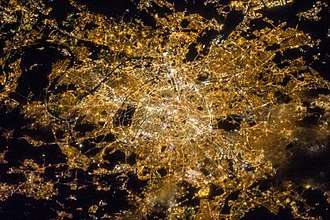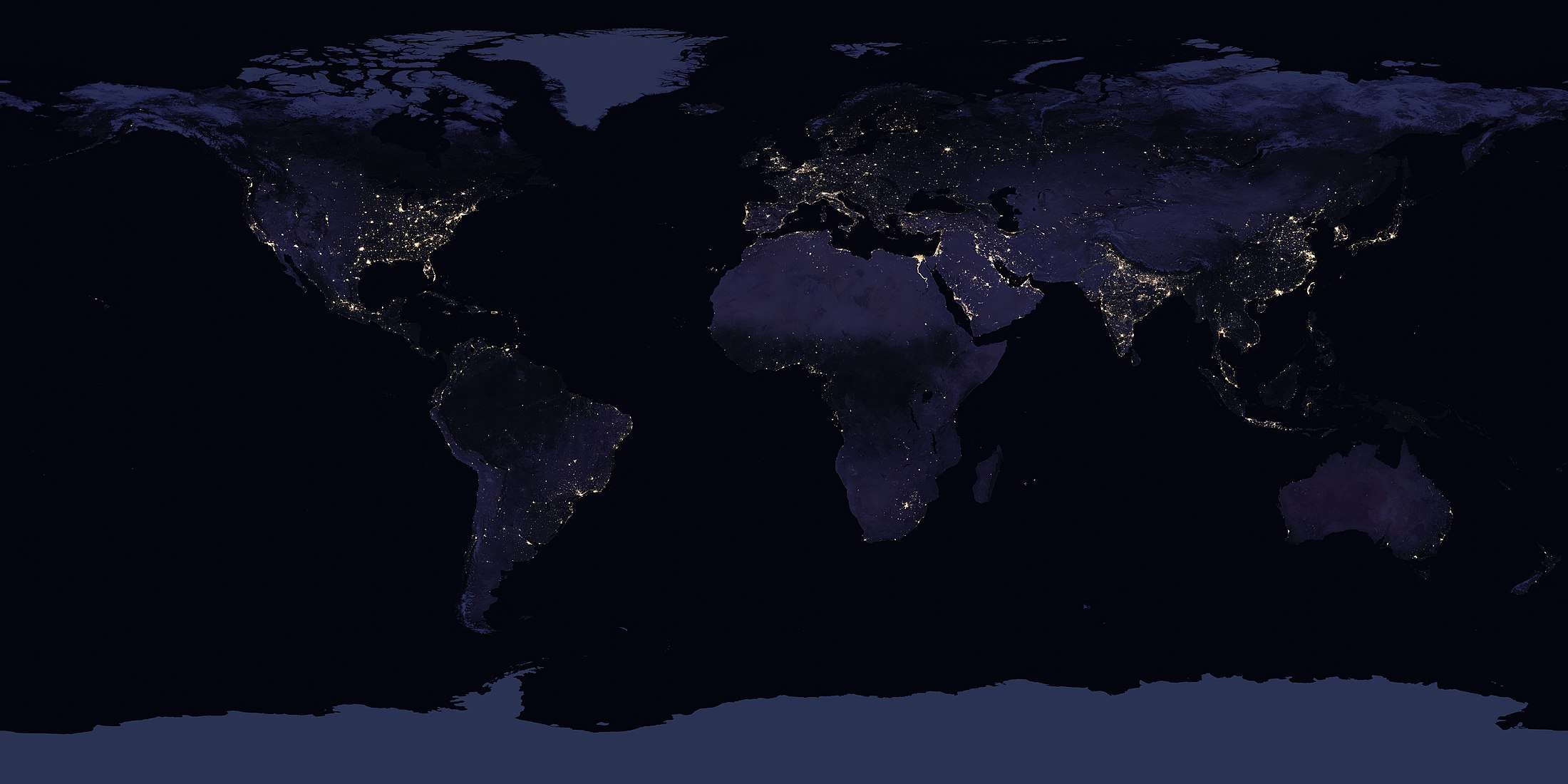Light pollution
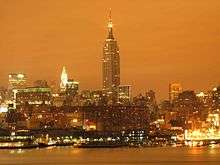
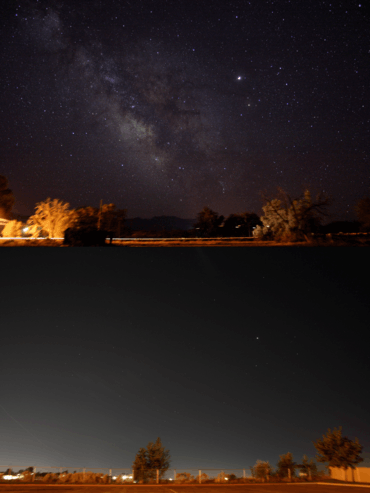
Light pollution, also known as photopollution, is the presence of anthropogenic light in the night environment. It is exacerbated by excessive, misdirected or obtrusive uses of light, but even carefully used light fundamentally alters natural conditions. As a major side-effect of urbanization, it is blamed for compromising health, disrupting ecosystems and spoiling aesthetic environments.
Definitions
Light pollution is the adding-of/added light itself, in analogy to added sound, carbon dioxide, etc. Adverse consequences are multiple; some of them may not be known yet. Scientific definitions thus include the following:
- The degradation of photic habitat by artificial light.[1]
- The alteration of natural light levels in the outdoor environment owing to artificial light sources.[2]
- The alteration of light levels in the outdoor environment (from those present naturally) due to man-made sources of light. Indoor light pollution is such alteration of light levels in the indoor environment due to sources of light, which compromises human health.[3]
- The introduction by humans, directly or indirectly, of artificial light into the environment.[4]
The first three of the above four scientific definitions describe the state of the environment. The fourth (and newest) one describes the process of polluting by light.
Light pollution competes with starlight in the night sky for urban residents, interferes with astronomical observatories,[5] and, like any other form of pollution, disrupts ecosystems and has adverse health effects[6][7]
Light pollution is a side-effect of industrial civilization. Its sources include building exterior and interior lighting, advertising, outdoor area lighting (e.g. car parks/parking lots), offices, factories, streetlights, and illuminated sporting venues. It is most severe in highly industrialized, densely populated areas of North America, Europe, and Japan and in major cities in the Middle East and North Africa like Tehran and Cairo, but even relatively small amounts of light can be noticed and create problems. Awareness of the deleterious effects of light pollution began early in the 20th Century (see e.g. Beston[8]), but efforts to address effects did not begin until the 1950s.[9] In the 1980s a global dark-sky movement emerged with the founding of the International Dark-Sky Association (IDA). There are now such educational and advocacy organizations in many countries worldwide.
Impact on energy usage
Energy conservation advocates contend that light pollution must be addressed by changing the habits of society, so that lighting is used more efficiently, with less waste and less creation of unwanted or unneeded illumination. Several industry groups also recognize light pollution as an important issue. For example, the Institution of Lighting Engineers in the United Kingdom provides its members with information about light pollution, the problems it causes, and how to reduce its impact.[10] Although, recent research[11] point that the energy efficiency is not enough to reduce the light pollution because of the rebound effect.
Since not everyone is irritated by the same lighting sources, it is common for one person's light "pollution" to be light that is desirable for another. One example of this is found in advertising, when an advertiser wishes for particular lights to be bright and visible, even though others find them annoying. Other types of light pollution are more certain. For instance, light that accidentally crosses a property boundary and annoys a neighbor is generally wasted and pollutive light.
Disputes are still common when deciding appropriate action; and differences in opinion over what light is considered reasonable, and who should be responsible, mean that negotiation must sometimes take place between parties. Where objective measurement is desired, light levels can be quantified by field measurement or mathematical modeling, with results typically displayed as an isophote map or light contour map. Authorities have also taken a variety of measures for dealing with light pollution, depending on the interests, beliefs and understandings of the society involved. Measures range from doing nothing at all, to implementing strict laws and regulations about how lights may be installed and used.
Types
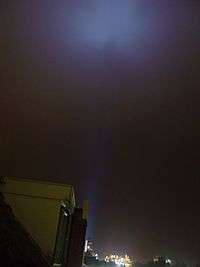
Light pollution is a broad term that refers to multiple problems, all of which are caused by inefficient, unappealing, or (arguably) unnecessary use of artificial light. Specific categories of light pollution include light trespass, over-illumination, glare, light clutter, and skyglow. A single offending light source often falls into more than one of these categories.
Light trespass
Light trespass occurs when unwanted light enters one's property, for instance, by shining over a neighbor's fence. A common light trespass problem occurs when a strong light enters the window of one's home from the outside, causing problems such as sleep deprivation. A number of cities in the U.S. have developed standards for outdoor lighting to protect the rights of their citizens against light trespass. To assist them, the International Dark-Sky Association has developed a set of model lighting ordinances.[12]
The Dark-Sky Association was started to reduce the light going up into the sky which reduces visibility of stars (see Skyglow below). This is any light which is emitted more than 90° above nadir. By limiting light at this 90° mark they have also reduced the light output in the 80–90° range which creates most of the light trespass issues.

U.S. federal agencies may also enforce standards and process complaints within their areas of jurisdiction. For instance, in the case of light trespass by white strobe lighting from communication towers in excess of FAA minimum lighting requirements[13] the Federal Communications Commission maintains an Antenna Structure Registration database[14] information which citizens may use to identify offending structures and provides a mechanism for processing citizen inquiries and complaints.[15] The U.S. Green Building Council (USGBC) has also incorporated a credit for reducing the amount of light trespass and sky glow into their environmentally friendly building standard known as LEED.
Light trespass can be reduced by selecting light fixtures which limit the amount of light emitted more than 80° above the nadir. The IESNA definitions include full cutoff (0%), cutoff (10%), and semi-cutoff (20%). (These definitions also include limits on light emitted above 90° to reduce sky glow.)
Over-illumination
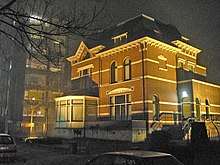
Over-illumination is the excessive use of light. Specifically within the United States, over-illumination is responsible for approximately two million barrels of oil per day in energy wasted. This is based upon U.S. consumption of equivalent of 18.8 million barrels per day (2,990,000 m3/d) of petroleum.[16] It is further noted in the same U.S. Department of Energy source that over 30% of all primary energy is consumed by commercial, industrial and residential sectors. Energy audits of existing buildings demonstrate that the lighting component of residential, commercial and industrial uses consumes about 20–40% of those land uses, variable with region and land use. (Residential use lighting consumes only 10–30% of the energy bill while commercial buildings' major use is lighting.[17]) Thus lighting energy accounts for about four or five million barrels of oil (equivalent) per day. Again energy audit data demonstrates that about 30–60% of energy consumed in lighting is unneeded or gratuitous.[18]
An alternative calculation starts with the fact that commercial building lighting consumes in excess of 81.68 terawatts (1999 data) of electricity,[19] according to the U.S. DOE. Thus commercial lighting alone consumes about four to five million barrels per day (equivalent) of petroleum, in line with the alternate rationale above to estimate U.S. lighting energy consumption. Even among developed countries there are large differences in patterns of light use. American cities emit 3–5 times more light to space per capita compared to German cities.[20]
Over-illumination stems from several factors:
- Consensus based standards or norms that are not based on vision science;[21]
- Not using timers, occupancy sensors or other controls to extinguish lighting when not needed;
- Improper design, by specifying higher levels of light than needed for a given visual task;[22]
- Incorrect choice of fixtures or light bulbs, which do not direct light into areas as needed;[22]
- Improper selection of hardware to utilize more energy than needed to accomplish the lighting task;
- Incomplete training of building managers and occupants to use lighting systems efficiently;
- Inadequate lighting maintenance resulting in increased stray light and energy costs;
- "Daylight lighting" demanded by citizens to reduce crime or by shop owners to attract customers;[23]
- Substitution of old lamps with more efficient LEDs using the same electrical power; and
- Indirect lighting techniques, such as illuminating a vertical wall to bounce light onto the ground.
Most of these issues can be readily corrected with available, inexpensive technology, and with resolution of landlord/tenant practices that create barriers to rapid correction of these matters. Most importantly, public awareness would need to improve for industrialized countries to realize the large payoff in reducing over-illumination.
In certain cases an over-illumination lighting technique may be needed. For example, indirect lighting is often used to obtain a "softer" look, since hard direct lighting is generally found less desirable for certain surfaces, such as skin. The indirect lighting method is perceived as more cozy and suits bars, restaurants and living quarters. It is also possible to block the direct lighting effect by adding softening filters or other solutions, though intensity will be reduced.
Glare
Glare can be categorized into different types. One such classification is described in a book by Bob Mizon, coordinator for the British Astronomical Association's Campaign for Dark Skies, as follows:[24]
- Blinding glare describes effects such as that caused by staring into the Sun. It is completely blinding and leaves temporary or permanent vision deficiencies.
- Disability glare describes effects such as being blinded by oncoming car lights, or light scattering in fog or in the eye, reducing contrast, as well as reflections from print and other dark areas that render them bright, with significant reduction in sight capabilities.
- Discomfort glare does not typically cause a dangerous situation in itself, though it is annoying and irritating at best. It can potentially cause fatigue if experienced over extended periods.
According to Mario Motta, president of the Massachusetts Medical Society, "... glare from bad lighting is a public-health hazard—especially the older you become. Glare light scattering in the eye causes loss of contrast and leads to unsafe driving conditions, much like the glare on a dirty windshield from low-angle sunlight or the high beams from an oncoming car."[25] In essence bright and/or badly shielded lights around roads can partially blind drivers or pedestrians and contribute to accidents.
The blinding effect is caused in large part by reduced contrast due to light scattering in the eye by excessive brightness, or to reflection of light from dark areas in the field of vision, with luminance similar to the background luminance. This kind of glare is a particular instance of disability glare, called veiling glare. (This is not the same as loss of accommodation of night vision which is caused by the direct effect of the light itself on the eye.)

Light clutter
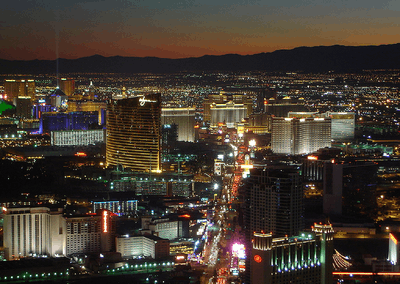
Light clutter refers to excessive groupings of lights. Groupings of lights may generate confusion, distract from obstacles (including those that they may be intended to illuminate), and potentially cause accidents. Clutter is particularly noticeable on roads where the street lights are badly designed, or where brightly lit advertising surrounds the roadways. Depending on the motives of the person or organization that installed the lights, their placement and design can even be intended to distract drivers, and can contribute to accidents.
Measurement and global effects
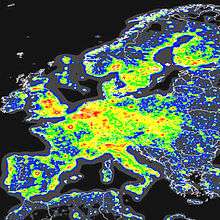
Measuring the effect of sky glow on a global scale is a complex procedure. The natural atmosphere is not completely dark, even in the absence of terrestrial sources of light and illumination from the Moon. This is caused by two main sources: airglow and scattered light.
At high altitudes, primarily above the mesosphere, there is enough UV radiation from the sun of very short wavelength to cause ionization. When the ions collide with electrically neutral particles they recombine and emit photons in the process, causing airglow. The degree of ionization is sufficiently large to allow a constant emission of radiation even during the night when the upper atmosphere is in the Earth's shadow. Lower in the atmosphere all of the solar photons with energies above the ionization potential of N2 and O2 have already been absorbed by the higher layers and thus no appreciable ionization occurs.
Apart from emitting light, the sky also scatters incoming light, primarily from distant stars and the Milky Way, but also the zodiacal light, sunlight that is reflected and backscattered from interplanetary dust particles.
The amount of airglow and zodiacal light is quite variable (depending, amongst other things on sunspot activity and the Solar cycle) but given optimal conditions the darkest possible sky has a brightness of about 22 magnitude/square arcsecond. If a full moon is present, the sky brightness increases to about 18 magnitude/sq. arcsecond depending on local atmospheric transparency, 40 times brighter than the darkest sky. In densely populated areas a sky brightness of 17 magnitude/sq. arcsecond is not uncommon, or as much as 100 times brighter than is natural.
To precisely measure how bright the sky gets, night time satellite imagery of the earth is used as raw input for the number and intensity of light sources. These are put into a physical model[26] of scattering due to air molecules and aerosoles to calculate cumulative sky brightness. Maps that show the enhanced sky brightness have been prepared for the entire world.[27]
Inspection of the area surrounding Madrid reveals that the effects of light pollution caused by a single large conglomeration can be felt up to 100 km (62 mi) away from the center.[28] Global effects of light pollution are also made obvious. The entire area consisting of southern England, Netherlands, Belgium, west Germany, and northern France have a sky brightness of at least 2 to 4 times above normal (see above right). The only places in continental Europe where the sky can attain its natural darkness are in northern Scandinavia and in islands far from the continent.
In North America the situation is comparable. There is a significant problem with light pollution ranging from the Canadian Maritime Provinces to the American Southwest.[28] The International Dark-Sky Association works to designate areas that have high quality night skies. These areas are supported by communities and organizations that are dedicated to reducing light pollution (e.g.Dark-sky preserve). The National Park Service Natural Sounds and Night Skies Division has measured night sky quality in national park units across the U.S. Sky quality in the U.S. ranges from pristine (Capitol Reef National Park and Big Bend National Park) to severely degraded (Santa Monica Mountains National Recreation Area and Biscayne National Park).[29] The National Park Service Night Sky Program monitoring database is available online (2015).[30]
Light pollution in Hong Kong was declared the 'worst on the planet' in March 2013.[31]
In June 2016, it was estimated that one third of the world's population could no longer see the Milky Way, including 80% of Americans and 60% of Europeans. Singapore was found to be the most light-polluted country in the world.[32][28]
Consequences
Effects on human health and psychology
Medical research on the effects of excessive light on the human body suggests that a variety of adverse health effects may be caused by light pollution or excessive light exposure, and some lighting design textbooks[33] use human health as an explicit criterion for proper interior lighting. Health effects of over-illumination or improper spectral composition of light may include: increased headache incidence, worker fatigue, medically defined stress, decrease in sexual function and increase in anxiety.[34][35][36][37] Likewise, animal models have been studied demonstrating unavoidable light to produce adverse effect on mood and anxiety.[38] For those who need to be awake at night, light at night also has an acute effect on alertness and mood.[39]
In 2007, "shift work that involves circadian disruption" was listed as a probable carcinogen by the World Health Organization's International Agency for Research on Cancer. (IARC Press release No. 180).[40][41] Multiple studies have documented a correlation between night shift work and the increased incidence of breast and prostate cancer.[42][43][44][45][46][47] One study which examined the link between exposure to artificial light at night (ALAN) and levels of breast cancer in South Korea found that regions which had the highest levels of ALAN reported the highest number of cases of breast cancer. Seoul, which had the highest levels of light pollution, had 34.4% more cases of breast cancer than Ganwon-do, which had the lowest levels of light pollution. This suggested a high correlation between ALAN and the prevalence of breast cancer.It was also found that there was no correlation between other types of cancer such as cervical or lung cancer and ALAN levels.[48]
A more recent discussion (2009), written by Professor Steven Lockley, Harvard Medical School, can be found in the CfDS handbook "Blinded by the Light?".[49] Chapter 4, "Human health implications of light pollution" states that "... light intrusion, even if dim, is likely to have measurable effects on sleep disruption and melatonin suppression. Even if these effects are relatively small from night to night, continuous chronic circadian, sleep and hormonal disruption may have longer-term health risks". The New York Academy of Sciences hosted a meeting in 2009 on Circadian Disruption and Cancer.[50] Red light suppresses melatonin the least.[51]
In June 2009, the American Medical Association developed a policy in support of control of light pollution. News about the decision emphasized glare as a public health hazard leading to unsafe driving conditions. Especially in the elderly, glare produces loss of contrast, obscuring night vision.[25]
Disruption of ecosystems
When artificial light affects organisms and ecosystems it is called ecological light pollution. While light at night can be beneficial, neutral, or damaging for individual species, its presence invariably disturbs ecosystems. For example, some species of spiders avoid lit areas, while other species are happy to build their spider web directly on a lamp post. Since lamp posts attract many flying insects, the spiders that don't mind light gain an advantage over the spiders that avoid it. This is a simple example of the way in which species frequencies and food webs can be disturbed by the introduction of light at night.
Light pollution poses a serious threat in particular to nocturnal wildlife, having negative impacts on plant and animal physiology. It can confuse animal navigation, alter competitive interactions, change predator-prey relations, and cause physiological harm.[52] The rhythm of life is orchestrated by the natural diurnal patterns of light and dark, so disruption to these patterns impacts the ecological dynamics.[53]
Studies suggest that light pollution around lakes prevents zooplankton, such as Daphnia, from eating surface algae, causing algal blooms that can kill off the lakes' plants and lower water quality.[54] Light pollution may also affect ecosystems in other ways. For example, lepidopterists and entomologists have documented that nighttime light may interfere with the ability of moths and other nocturnal insects to navigate.[55] Night-blooming flowers that depend on moths for pollination may be affected by night lighting, as there is no replacement pollinator that would not be affected by the artificial light. This can lead to species decline of plants that are unable to reproduce, and change an area's longterm ecology.[56] Among nocturnal insects, fireflies (Coleoptera: Lampyridae, Phengodidae and Elateridae) are especially interesting study objects for light pollution, once they depend on their own light to reproduce and, consequently, are very sensitive to environmental levels of light.[57][58][59] In 2015 it was shown and quantified for the first time the negative effects of direct illumination on fireflies, in a study that monitored populations over four years.[60] Fireflies are charismatic[61] (which is a rare quality among insects) and are easily spotted by nonexperts, providing thus good flagship species to attract public attention;[60] good investigation models for the effects of light on nocturnal wildlife;[60] and finally, due to their sensibility and rapid response to environmental changes, good bioindicators for artificial night lighting.[62] Massive insect declines have been suggested as being at least partially mediated by artificial lights at night.[63]
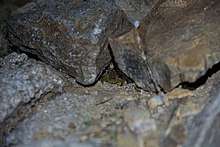
A 2009 study[64] also suggests deleterious impacts on animals and ecosystems because of perturbation of polarized light or artificial polarization of light (even during the day, because direction of natural polarization of sun light and its reflection is a source of information for a lot of animals). This form of pollution is named polarized light pollution (PLP). Unnatural polarized light sources can trigger maladaptive behaviors in polarization-sensitive taxa and alter ecological interactions.[64]
Lights on tall structures can disorient migrating birds. Estimates by the U.S. Fish and Wildlife Service of the number of birds killed after being attracted to tall towers range from 4 to 5 million per year to an order of magnitude higher.[65] The Fatal Light Awareness Program (FLAP) works with building owners in Toronto, Ontario, Canada and other cities to reduce mortality of birds by turning out lights during migration periods.
Similar disorientation has also been noted for bird species migrating close to offshore production and drilling facilities. Studies carried out by Nederlandse Aardolie Maatschappij b.v. (NAM) and Shell have led to development and trial of new lighting technologies in the North Sea. In early 2007, the lights were installed on the Shell production platform L15. The experiment proved a great success since the number of birds circling the platform declined by 50 to 90%.[66]
Sea turtle hatchlings emerging from nests on beaches are another casualty of light pollution. It is a common misconception that hatchling sea turtles are attracted to the moon. Rather, they find the ocean by moving away from the dark silhouette of dunes and their vegetation, a behavior with which artificial lights interfere.[67] The breeding activity and reproductive phenology of toads, however, are cued by moonlight.[68] Juvenile seabirds may also be disoriented by lights as they leave their nests and fly out to sea.[69][70][71] Amphibians and reptiles are also affected by light pollution. Introduced light sources during normally dark periods can disrupt levels of melatonin production. Melatonin is a hormone that regulates photoperiodic physiology and behaviour. Some species of frogs and salamanders utilize a light-dependent "compass" to orient their migratory behaviour to breeding sites. Introduced light can also cause developmental irregularities, such as retinal damage, reduced juvenile growth, premature metamorphosis,[72] reduced sperm production, and genetic mutation.[52][73][74][57][75][76]
In September 2009, the 9th European Dark-Sky Symposium in Armagh, Northern Ireland had a session on the environmental effects of light at night (LAN). It dealt with bats, turtles, the "hidden" harms of LAN, and many other topics.[77] The environmental effects of LAN were mentioned as early as 1897, in a Los Angeles Times article. The following is an excerpt from that article, called "Electricity and English songbirds":
An English journal has become alarmed at the relation of electricity to songbirds, which it maintains is closer than that of cats and fodder crops. How many of us, it asks, foresee that electricity may extirpate the songbird?...With the exception of the finches, all the English songbirds may be said to be insectivorous, and their diet consists chiefly of vast numbers of very small insects which they collect from the grass and herbs before the dew is dry. As the electric light is finding its way for street illumination into the country parts of England, these poor winged atoms are slain by thousands at each light every warm summer evening....The fear is expressed, that when England is lighted from one end to the other with electricity the song birds will die out from the failure of their food supply.[78]
Effect on astronomy
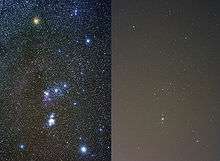
Astronomy is very sensitive to light pollution. The night sky viewed from a city bears no resemblance to what can be seen from dark skies.[79] Skyglow (the scattering of light in the atmosphere at night) reduces the contrast between stars and galaxies and the sky itself, making it much harder to see fainter objects. This is one factor that has caused newer telescopes to be built in increasingly remote areas.
Some astronomers use narrow-band "nebula filters", which only allow specific wavelengths of light commonly seen in nebulae, or broad-band "light pollution filters", which are designed to reduce (but not eliminate) the effects of light pollution by filtering out spectral lines commonly emitted by sodium- and mercury-vapor lamps, thus enhancing contrast and improving the view of dim objects such as galaxies and nebulae.[80] Unfortunately, these light pollution reduction (LPR) filters are not a cure for light pollution. LPR filters reduce the brightness of the object under study and this limits the use of higher magnifications. LPR filters work by blocking light of certain wavelengths, which alters the color of the object, often creating a pronounced green cast. Furthermore, LPR filters only work on certain object types (mainly emission nebulae) and are of little use on galaxies and stars. No filter can match the effectiveness of a dark sky for visual or photographic purposes.
Light pollution affects the visibility of diffuse sky objects like nebulae and galaxies more than stars, due to their low surface brightness. Most such objects are rendered invisible in heavily light-polluted skies above major cities. A simple method for estimating the darkness of a location is to look for the Milky Way, which from truly dark skies appears bright enough to cast a shadow.[81]

In addition to skyglow, light trespass can impact observations when artificial light directly enters the tube of the telescope and is reflected from non-optical surfaces until it eventually reaches the eyepiece. This direct form of light pollution causes a glow across the field of view, which reduces contrast. Light trespass also makes it hard for a visual observer to become sufficiently adapted to the dark. The usual measures to reduce this glare, if reducing the light directly is not an option, include flocking the telescope tube and accessories to reduce reflection, and putting a light shield (also usable as a dew shield) on the telescope to reduce light entering from angles other than those near the target. Under these conditions, some astronomers prefer to observe under a black cloth to ensure maximum adaptation to the dark.
Increase in atmospheric pollution
A study presented at the American Geophysical Union meeting in San Francisco found that light pollution destroys nitrate radicals thus preventing the normal night time reduction of atmospheric smog produced by fumes emitted from cars and factories.[83][84] The study was presented by Harald Stark from the National Oceanic and Atmospheric Administration.
Reduction of natural sky polarization
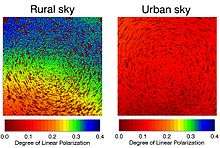
In the night, the polarization of the moonlit sky is very strongly reduced in the presence of urban light pollution, because scattered urban light is not strongly polarized.[85] Polarized moonlight can't be seen by humans, but is believed to be used by many animals for navigation.
Reduction
Reducing light pollution implies many things, such as reducing sky glow, reducing glare, reducing light trespass, and reducing clutter. The method for best reducing light pollution, therefore, depends on exactly what the problem is in any given instance. Possible solutions include:
- Utilizing light sources of minimum intensity necessary to accomplish the light's purpose.
- Turning lights off using a timer or occupancy sensor or manually when not needed.
- Improving lighting fixtures, so that they direct their light more accurately towards where it is needed, and with fewer side effects.
- Adjusting the type of lights used, so that the light waves emitted are those that are less likely to cause severe light pollution problems. Mercury, metal halide and above all first generation of blue-light LED road luminaires are much more polluting than sodium lamps: Earth's atmosphere scatters and transmits blue light better than yellow or red light. It is a common experience observing "glare" and "fog" around and below LED road luminaires as soon as air humidity increases, while orange sodium lamp luminaires are less prone to showing this phenomenon.
- Evaluating existing lighting plans, and re-designing some or all of the plans depending on whether existing light is actually needed.
Improving lighting fixtures
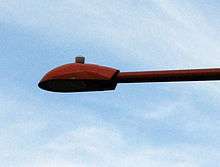
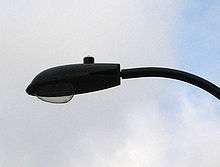
The use of full cutoff lighting fixtures, as much as possible, is advocated by most campaigners for the reduction of light pollution. It is also commonly recommended that lights be spaced appropriately for maximum efficiency, and that number of luminaires being used as well as the wattage of each luminaire match the needs of the particular application (based on local lighting design standards).
Full cutoff fixtures first became available in 1959 with the introduction of General Electric's M100 fixture.[86]
A full cutoff fixture, when correctly installed, reduces the chance for light to escape above the plane of the horizontal. Light released above the horizontal may sometimes be lighting an intended target, but often serves no purpose. When it enters into the atmosphere, light contributes to sky glow. Some governments and organizations are now considering, or have already implemented, full cutoff fixtures in street lamps and stadium lighting.
The use of full cutoff fixtures help to reduce sky glow by preventing light from escaping above the horizontal. Full cutoff typically reduces the visibility of the lamp and reflector within a luminaire, so the effects of glare are also reduced. Campaigners also commonly argue that full cutoff fixtures are more efficient than other fixtures, since light that would otherwise have escaped into the atmosphere may instead be directed towards the ground. However, full cutoff fixtures may also trap more light in the fixture than other types of luminaires, corresponding to lower luminaire efficiency, suggesting a re-design of some luminaires may be necessary.
The use of full cutoff fixtures can allow for lower wattage lamps to be used in the fixtures, producing the same or sometimes a better effect, due to being more carefully controlled. In every lighting system, some sky glow also results from light reflected from the ground. This reflection can be reduced, however, by being careful to use only the lowest wattage necessary for the lamp, and setting spacing between lights appropriately.[87] Assuring luminaire setback is greater than 90° from highly reflective surfaces also diminishes reflectance.
A common criticism of full cutoff lighting fixtures is that they are sometimes not as aesthetically pleasing to look at. This is most likely because historically there has not been a large market specifically for full cutoff fixtures, and because people typically like to see the source of illumination. Due to the specificity with their direction of light, full cutoff fixtures sometimes also require expertise to install for maximum effect.
The effectiveness of using full cutoff roadway lights to combat light pollution has also been called into question. According to design investigations, luminaires with full cutoff distributions (as opposed to cutoff or semi cutoff, compared here[88]) have to be closer together to meet the same light level, uniformity and glare requirements specified by the IESNA. These simulations optimized the height and spacing of the lights while constraining the overall design to meet the IESNA requirements, and then compared total uplight and energy consumption of different luminaire designs and powers. Cutoff designs performed better than full cutoff designs, and semi-cutoff performed better than either cutoff or full cutoff. This indicates that, in roadway installations, over-illumination or poor uniformity produced by full cutoff fixtures may be more detrimental than direct uplight created by fewer cutoff or semi-cutoff fixtures. Therefore, the overall performance of existing systems could be improved more by reducing the number of luminaires than by switching to full cutoff designs.
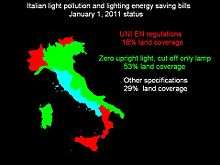
However, using the definition of "light pollution" from some Italian regional bills (i.e., "every irradiance of artificial light outside competence areas and particularly upward the sky") only full cutoff design prevents light pollution. The Italian Lombardy region, where only full cutoff design is allowed (Lombardy act no. 17/2000, promoted by Cielobuio-coordination for the protection of the night sky), in 2007 had the lowest per capita energy consumption for public lighting in Italy. The same legislation also imposes a minimum distance between street lamps of about four times their height, so full cut off street lamps are the best solution to reduce both light pollution and electrical power usage.
Adjusting types of light sources
Several different types of light sources exist, each having different properties that affect their appropriateness for certain tasks, particularly efficiency and spectral power distribution. It is often the case that inappropriate light sources have been selected for a task, either due to ignorance or because more sophisticated light sources were unavailable at the time of installation. Therefore, badly chosen light sources often contribute unnecessarily to light pollution and energy waste. By re-assessing and changing the light sources used, it is often possible to reduce energy use and pollutive effects while simultaneously greatly improving efficiency and visibility.
Some types of light sources are listed in order of energy efficiency in the table below (figures are approximate maintained values), and include relative visual skyglow impacts.[89][90]
| Type of light source | Color | Luminous efficacy (in lumens per watt) |
Sky glow impact (relative to LPS) |
|---|---|---|---|
| LED street light (white) | warm-white to cool-white | 120 | 4–8 |
| Low Pressure Sodium (LPS/SOX) | yellow/amber | 110 | 1.0 |
| High Pressure Sodium (HPS/SON) | pink/amber-white | 90 | 2.4 |
| Metal Halide | warm-white to cool-white | 70 | 4–8 |
| Incandescent | yellow/white | 8–25 | 1.1 |
Many astronomers request that nearby communities use low pressure sodium lights or amber Aluminium gallium indium phosphide LED as much as possible, because the principal wavelength emitted is comparably easy to work around or in rare cases filter out.[91] The low cost of operating sodium lights is another feature. In 1980, for example, San Jose, California, replaced all street lamps with low pressure sodium lamps, whose light is easier for nearby Lick Observatory to filter out. Similar programs are now in place in Arizona and Hawaii. Such yellow light sources also have significantly less visual skyglow impact,[92] so reduce visual sky brightness and improve star visibility for everyone.
Disadvantages of low pressure sodium lighting are that fixtures must usually be larger than competing fixtures, and that color cannot be distinguished, due to its emitting principally a single wavelength of light (see security lighting). Due to the substantial size of the lamp, particularly in higher wattages such as 135 W and 180 W, control of light emissions from low pressure sodium luminaires is more difficult. For applications requiring more precise direction of light (such as narrow roadways) the native lamp efficacy advantage of this lamp type is decreased and may be entirely lost compared to high pressure sodium lamps. Allegations that this also leads to higher amounts of light pollution from luminaires running these lamps arise principally because of older luminaires with poor shielding, still widely in use in the UK and in some other locations. Modern low-pressure sodium fixtures with better optics and full shielding, and the decreased skyglow impacts of yellow light preserve the luminous efficacy advantage of low-pressure sodium and result in most cases is less energy consumption and less visible light pollution. Unfortunately, due to continued lack of accurate information,[93] many lighting professionals continue to disparage low-pressure sodium, contributing to its decreased acceptance and specification in lighting standards and therefore its use. Another disadvantage of low-pressure sodium lamps is that some people find the characteristic yellow light very displeasing aesthetically.
Because of the increased sensitivity of the human eye to blue and green wavelengths when viewing low-luminances (the Purkinje effect) in the night sky, different sources produce dramatically different amounts of visible skyglow from the same amount of light sent into the atmosphere.
Re-designing lighting plans
In some cases, evaluation of existing plans has determined that more efficient lighting plans are possible. For instance, light pollution can be reduced by turning off unneeded outdoor lights, and only lighting stadiums when there are people inside. Timers are especially valuable for this purpose. One of the world's first coordinated legislative efforts to reduce the adverse effect of this pollution on the environment began in Flagstaff, Arizona, in the U.S. There, over three decades of ordinance development has taken place, with the full support of the population,[94] often with government support,[95] with community advocates,[96] and with the help of major local observatories,[97] including the United States Naval Observatory Flagstaff Station. Each component helps to educate, protect and enforce the imperatives to intelligently reduce detrimental light pollution.
One example of a lighting plan assessment can be seen in a report originally commissioned by the Office of the Deputy Prime Minister in the United Kingdom, and now available through the Department for Communities and Local Government.[98] The report details a plan to be implemented throughout the UK, for designing lighting schemes in the countryside, with a particular focus on preserving the environment.
In another example, the city of Calgary has recently replaced most residential street lights with models that are comparably energy efficient.[99] The motivation is primarily operation cost and environmental conservation. The costs of installation are expected to be regained through energy savings within six to seven years.
The Swiss Agency for Energy Efficiency (SAFE) uses a concept that promises to be of great use in the diagnosis and design of road lighting, "consommation électrique spécifique (CES)", which can be translated into English as "specific electric power consumption (SEC)".[100] Thus, based on observed lighting levels in a wide range of Swiss towns, SAFE has defined target values for electric power consumption per metre for roads of various categories. Thus, SAFE currently recommends an SEC of 2 to 3 watts per meter for roads of less than 10 metre width (4 to 6 watts per metre for wider roads). Such a measure provides an easily applicable environmental protection constraint on conventional "norms", which usually are based on the recommendations of lighting manufacturing interests, who may not take into account environmental criteria. In view of ongoing progress in lighting technology, target SEC values will need to be periodically revised downwards.
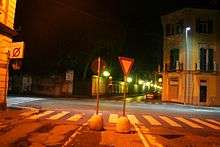
A newer method for predicting and measuring various aspects of light pollution was described in the journal Lighting Research Technology (September 2008). Scientists at Rensselaer Polytechnic Institute's Lighting Research Center have developed a comprehensive method called Outdoor Site-Lighting Performance (OSP), which allows users to quantify, and thus optimize, the performance of existing and planned lighting designs and applications to minimize excessive or obtrusive light leaving the boundaries of a property. OSP can be used by lighting engineers immediately, particularly for the investigation of glow and trespass (glare analyses are more complex to perform and current commercial software does not readily allow them), and can help users compare several lighting design alternatives for the same site.[101]
In the effort to reduce light pollution, researchers have developed a "Unified System of Photometry," which is a way to measure how much or what kind of street lighting is needed. The Unified System of Photometry allows light fixtures to be designed to reduce energy use while maintaining or improving perceptions of visibility, safety, and security.[102] There was a need to create a new system of light measurement at night because the biological way in which the eye’s rods and cones process light is different in nighttime conditions versus daytime conditions. Using this new system of photometry, results from recent studies have indicated that replacing traditional, yellowish, high-pressure sodium (HPS) lights with "cool" white light sources, such as induction, fluorescent, ceramic metal halide, or LEDs can actually reduce the amount of electric power used for lighting while maintaining or improving visibility in nighttime conditions.[103]
The International Commission on Illumination, also known as the CIE from its French title, la Commission Internationale de l'Eclairage, will soon be releasing its own form of unified photometry for outdoor lighting.
See also
- Bortle Dark-Sky Scale
- Campaign for Dark Skies (CfDS)
- Dark-sky preserve
- Earth Hour
- The End of Night (book)
- History of street lighting in the United States
- Light pollution in Hong Kong
- International Dark-Sky Association
- Lighting
- List of environmental health hazards
- National Dark-Sky Week
- Noise pollution
- Over-illumination
- Polarized light pollution
- Scotobiology
- Tribute in Light
- SKYGLOW
References
- ↑ Verheijen, F. J. (1985). "Photopollution: Artificial light optic spatial control systems fail to cope with. Incidents, causation, remedies". Experimental biology. 44 (1): 1–18. PMID 3896840.
- ↑ Cinzano, P.; Falchi, F.; Elvidge, C. D.; Baugh, K. E. (2000). "The artificial night sky brightness mapped from DMSP Operational Linescan System measurements" (PDF). Monthly Notices of the Royal Astronomical Society. 318 (3): 641–657. arXiv:astro-ph/0003412. Bibcode:2000MNRAS.318..641C. doi:10.1046/j.1365-8711.2000.03562.x.
- ↑ Hollan, J: What is light pollution, and how do we quantify it?. Darksky2008 conference paper, Vienna, August 2008. Updated April 2009.
- ↑ Marín, C. and Orlando, G. (eds.) (June 2009) Starlight Reserves and World Heritage. Starlight Initiative, IAC and the UNESCO World Heritage Centre. Fuerteventura, Spain.
- ↑ "Light Pollution and Palomar Observatory". Palomar Observatory: Caltech Astronomy.
- ↑ http://www.latimes.com/science/sciencenow/la-sci-sn-earth-artificial-light-night-darkness-20171122-story.html
- ↑ https://www.reuters.com/article/us-science-light/the-future-looks-bright-light-pollution-rises-on-a-global-scale-idUSKBN1DM2OK
- ↑ Beston, Henry (1928). The Outermost House. New York, New York: Henry Holt and Company. ISBN 080507368X.
- ↑ Portree, David. S. F. (2002). "Flagstaff's Battle for Dark Skies". The Griffith Observer (October, 2002).
- ↑ Light Nuisance. Institution of Light Engineers
- ↑ Kyba, Christopher C. M.; Kuester, Theres; Sánchez de Miguel, Alejandro; Baugh, Kimberly; Jechow, Andreas; Hölker, Franz; Bennie, Jonathan; Elvidge, Christopher D.; Gaston, Kevin J.; Guanter, Luis (22 November 2017). "Artificially lit surface of Earth at night increasing in radiance and extent". Science Advances. 3 (11): e1701528. Bibcode:2017SciA....3E1528K. doi:10.1126/sciadv.1701528.
- ↑ International Dark-Sky Association. darksky.org
- ↑ "AC 70/7460-1K Obstruction Marking and Lighting" (PDF). 2007-02-01. Retrieved 2009-07-04.
- ↑ "FCC Antenna Structure Registration". Retrieved 2009-07-04.
- ↑ "FCC Consumer & Governmental Affairs Bureau". U.S. Federal Communications Commission.
- ↑ "Oil: Crude and Petroleum Products Explained". Energy Explained. Energy Information Administration. April 23, 2012. Data & Statistics: Consumption and Disposition. Retrieved 2013-02-16.
- ↑ Irby Circuit – Energy Savings Archived 2006-03-15 at the Wayback Machine.. Irby.com. Retrieved 2011-12-03.
- ↑ Lumina Technologies, Santa Rosa, California, Survey of 156 California commercial buildings energy use, August, 1996
- ↑ Energy Information Administration — Commercial Energy Consumption Survey. Eia.doe.gov. Retrieved 2011-12-03.
- ↑ Kyba, Christopher; Garz, Stefanie; Kuechly, Helga; de Miguel, Alejandro; Zamorano, Jaime; Fischer, Jürgen; Hölker, Franz (23 December 2014). "High-Resolution Imagery of Earth at Night: New Sources, Opportunities and Challenges". Remote Sensing. 7 (1): 1–23. Bibcode:2014RemS....7....1K. doi:10.3390/rs70100001.
- ↑ Fotios, S; Gibbons, R (9 January 2018). "Road lighting research for drivers and pedestrians: The basis of luminance and illuminance recommendations". Lighting Research & Technology. 50 (1): 154–186. doi:10.1177/1477153517739055.
- 1 2 Kyba, Christopher C. M.; Mohar, Andrej; Pintar, Gašper; Stare, Jurij (20 February 2018). "Reducing the environmental footprint of church lighting: matching façade shape and lowering luminance with the EcoSky LED". International Journal of Sustainable Lighting. 19 (2): 132. doi:10.26607/ijsl.v19i2.80.
- ↑ Over-illumination can be a design choice, not a fault. In both cases target achievement is questionable.
- ↑ Mizon, Bob (2001) Light Pollution: Responses and Remedies. Springer. ISBN 1-85233-497-5
- 1 2 Motta, Mario (2009-06-22). "U.S. Physicians Join Light-Pollution Fight". news. Sky & Telescope. Retrieved 2009-06-23.
- ↑ "The first world atlas of the artificial night sky brightness" (PDF). Mon. Not. R. Astron. Soc. 328 (3): 689–707. 2001. arXiv:astro-ph/0108052. Bibcode:2001MNRAS.328..689C. doi:10.1046/j.1365-8711.2001.04882.x. Archived from the original (PDF) on 2006-08-19.
- ↑ (in Italian) The World Atlas of the Artificial Night Sky Brightness. Lightpollution.it. Retrieved 2011-12-03.
- 1 2 3 Falchi, Fabio; Cinzano, Pierantonio; Duriscoe, Dan; Kyba, Christopher C. M.; Elvidge, Christopher D.; Baugh, Kimberly; Portnov, Boris A.; Rybnikova, Nataliya A.; Furgoni, Riccardo (2016-06-01). "The new world atlas of artificial night sky brightness". Science Advances. 2 (6): e1600377. arXiv:1609.01041. Bibcode:2016SciA....2E0377F. doi:10.1126/sciadv.1600377. ISSN 2375-2548. PMC 4928945. PMID 27386582.
- ↑ Duriscoe D.; Luginbuhl C.; Moore C. "Measuring Night Sky Brightness with a Wide-Field CCD Camera". Publications of the Astronomical Society of the Pacific. 119: 192–213. arXiv:astro-ph/0702721. Bibcode:2007PASP..119..192D. doi:10.1086/512069.
- ↑ Night Sky Monitoring Database. nature.nps.gov
- ↑ South China Morning Post. 2013-20-3. Retrieved 2013-6-4
- ↑ Dennis, Brady (June 11, 2016). "Light pollution limiting night-sky views". Portland Press Herald, via Washington Post. Retrieved June 12, 2016.
- ↑ Gary Steffy, Architectural Lighting Design, John Wiley and Sons (2001) ISBN 0-471-38638-3.
- ↑ Burks, Susan L. (1994) Managing your Migraine, Humana Press, New Jersey. ISBN 0-89603-277-9.
- ↑ Cambridge Handbook of Psychology, Health and Medicine, edited by Andrew Baum, Robert West, John Weinman, Stanton Newman, Chris McManus, Cambridge University Press (1997) ISBN 0-521-43686-9
- ↑ Pijnenburg, L.; Camps, M. and Jongmans-Liedekerken, G. (1991) Looking closer at assimilation lighting, Venlo, GGD, Noord-Limburg
- ↑ Knez, I (2001). "Effects of colour of light on nonvisual psychological processes". Journal of Environmental Psychology. 21 (2): 201–208. doi:10.1006/jevp.2000.0198.
- ↑ Fonken, L K; Finy, M S; Walton, James C.; Weil, Zachary M.; Workman, Joanna L.; Ross, Jessica; Nelson, Randy J. (28 December 2009). "Influence of light at night on murine anxiety- and depressive-like responses". Behavioural Brain Research. 205 (2): 349–354. doi:10.1016/j.bbr.2009.07.001. PMID 19591880.
- ↑ Plitnick B; Figueiro MG; Wood B; Rea MS (2010). "The effects of long-wavelength red and short-wavelength blue lights on alertness and mood at night". Lighting Research and Technology. 42 (4): 449–458. doi:10.1177/1477153509360887.
- ↑ "IARC Monographs Programme finds cancer hazards associated with shiftwork, painting and firefighting, International Agency for Research on Cancer". Retrieved 2011-07-06.
- ↑ "IARC Monograph 98". Retrieved 2011-07-06.
- ↑ Schernhammer, ES; Schulmeister, K (2004). "Melatonin and cancer risk: does light at night compromise physiologic cancer protection by lowering serum melatonin levels?". British Journal of Cancer. 90 (5): 941–3. doi:10.1038/sj.bjc.6601626. PMC 2409637. PMID 14997186.
- ↑ Hansen, J (2001). "Increased breast cancer risk among women who work predominantly at night". Epidemiology. 12 (1): 74–7. doi:10.1097/00001648-200101000-00013. PMID 11138824.
- ↑ Davis, S; Mirick, DK; Stevens, RG (2001). "Night shift work, light at night, and risk of breast cancer" (PDF). Journal of the National Cancer Institute. 93 (20): 1557–62. doi:10.1093/jnci/93.20.1557. PMID 11604479. Archived from the original (PDF) on 2012-05-13.
- ↑ Schernhammer, ES; Laden, F; Speizer, FE; Willett, WC; Hunter, DJ; Kawachi, I; Colditz, GA (2001). "Rotating night shifts and risk of breast cancer in women participating in the nurses' health study". Journal of the National Cancer Institute. 93 (20): 1563–8. doi:10.1093/jnci/93.20.1563. PMID 11604480.
- ↑ Bullough, JD; Rea, MS; Figueiro, MG (2006). "Of mice and women: light as a circadian stimulus in breast cancer research" (PDF). Cancer Causes & Control. 17 (4): 375–83. doi:10.1007/s10552-005-0574-1. PMID 16596289.
- ↑ Kloog, I; Haim, A; Stevens, RG; Portnov, BA (2009). "Global co-distribution of light at night (LAN) and cancers of prostate, colon, and lung in men". Chronobiology International. 26 (1): 108–25. doi:10.1080/07420520802694020. PMID 19142761.
- ↑ Yun Jeong; et al. (2015). "High prevalence of breast cancer in light polluted areas in urban and rural regions of South Korea:An ecologic study on the treatment prevalence of female cancers based on National Health Insurance data". Chronobiology International. 32: 657–667.
- ↑ "CfDS Handbook". Britastro.org. Archived from the original on 2010-06-17. Retrieved 2010-09-04.
- ↑ "Event – Circadian Disruption and Cancer on Nature Network". Network.nature.com. Archived from the original on 2011-05-12. Retrieved 2010-09-04.
- ↑ Cheung, Maria (2009-11-29). "Graveyard Shift Work Linked to Cancer". news. University of Connecticut Health Center. Retrieved 2012-07-06.
- 1 2 Perry, G.; Buchanan, B. W.; Fisher, R. N.; Salmon, M.; Wise, S. E. (2008). "Effects of artificial night lighting on amphibians and reptiles in urban environments". In Bartholomew, J. C.; Mitchell, R. E. J.; Brown, B. Urban Herpetology. 3. Society for the Study of Amphibians and Reptiles. pp. 239–256. ISBN 0-916984-79-6.
- ↑ "Ecological light pollution" (PDF). Frontiers in Ecology and the Environment. 2 (4): 191–198. 2004. doi:10.1890/1540-9295(2004)002[0191:ELP]2.0.CO;2.
- ↑ Moore, Marianne V.; Pierce, Stephanie M.; Walsh, Hannah M.; Kvalvik, Siri K. & Julie D. Lim (2000). "Urban light pollution alters the diel vertical migration of Daphnia" (PDF). Verh. Internat. Verein. Limnol. 27: 1–4.
- ↑ Frank, Kenneth D. (1988). "Impact of outdoor lighting on moths". Journal of the Lepidopterists' Society. International Dark-Sky Association. 42: 63–93. Archived from the original on 2006-06-17.
- ↑ Confirmed: Night Lights Drive Pollinators Away From Plants The Atlantic, 2017
- 1 2 Rich, Catherine & Longcore, Travis (2006). Ecological consequences of artificial night lighting. Island Press. ISBN 1-55963-128-7.
- ↑ Lloyd, James E.; Wing, Steven R.; Hongtrakul, Tawatchai (1989). "Ecology, Flashes, and Behavior of Congregating Thai Fireflies". Biotropica. 21 (4): 373–376. doi:10.2307/2388290. JSTOR 2388290.
- ↑ Firebaugh, Ariel; Haynes, Kyle J. (2016-12-01). "Experimental tests of light-pollution impacts on nocturnal insect courtship and dispersal". Oecologia. 182 (4): 1203–1211. Bibcode:2016Oecol.182.1203F. doi:10.1007/s00442-016-3723-1. ISSN 0029-8549.
- 1 2 3 Hagen, Oskar; Santos, Raphael Machado; Schlindwein, Marcelo Nivert; Viviani, Vadim Ravara (2015-01-14). "Artificial Night Lighting Reduces Firefly (Coleoptera: Lampyridae) Occurrence in Sorocaba, Brazil". Advances in Entomology. 03 (01): 24.
- ↑ Picchi, Malayka Samantha; Avolio, Lerina; Azzani, Laura; Brombin, Orietta; Camerini, Giuseppe (2013-08-01). "Fireflies and land use in an urban landscape: the case of Luciola italica L. (Coleoptera: Lampyridae) in the city of Turin". Journal of Insect Conservation. 17 (4): 797–805. doi:10.1007/s10841-013-9562-z. ISSN 1366-638X.
- ↑ Viviani, Vadim Ravara; Rocha, Mayra Yamazaki; Hagen, Oskar (June 2010). "Bioluminescent beetles (Coleoptera: Elateroidea: Lampyridae, Phengodidae, Elateridae) in the municipalities of Campinas, Sorocaba-Votorantim and Rio Claro-Limeira (SP, Brazil): biodiversity and influence of urban sprawl". Biota Neotropica. 10 (2): 103–116. doi:10.1590/S1676-06032010000200013. ISSN 1676-0603.
- ↑ Grubisic, M.; van Grunsven, R.H.A.; Kyba, C.C.M.; Manfrin, A.; Hölker, F. (2018-06-11). "Insect declines and agroecosystems: does light pollution matter?". Annals of Applied Biology. doi:10.1111/aab.12440. ISSN 0003-4746.
- 1 2 Horváth, Gábor; Gábor Horváth; György Kriska; Péter Malik; Bruce Robertson (August 2009). "Polarized light pollution: a new kind of ecological photopollution". Frontiers in Ecology and the Environment. Accès Online. 7 (6): 317–325. doi:10.1890/080129.
- ↑ Malakoff, D. (2001). "Faulty towers". Audubon. 103 (5): 78–83.
- ↑ "Welkom op de site van de Nederlandse Aardolie Maatschappij BV". Nam.nl. 2009-03-26. Retrieved 2010-09-04.
- ↑ Salmon, M. (2003). "Artificial night lighting and sea turtles" (PDF). Biologist. 50: 163–168.
- ↑ "The lunar cycle: a cue for amphibian reproductive phenology?". Animal Behaviour. 78 (2): 349–357. 2009. doi:10.1016/j.anbehav.2009.05.007.
- ↑ RodrÍguez, Airam; RodrÍguez, Beneharo (2009). "Attraction of petrels to artificial lights in the Canary Islands: effects of the moon phase and age class". Ibis. 151 (2): 299–310. doi:10.1111/j.1474-919X.2009.00925.x.
- ↑ Rodríguez, A.; Rodríguez, B.; Curbelo, Á. J.; Pérez, A.; Marrero, S.; Negro, J. J. (2012). "Factors affecting mortality of shearwaters stranded by light pollution" (PDF). Animal Conservation. 15 (5): 519–526. doi:10.1111/j.1469-1795.2012.00544.x.
- ↑ Rodríguez, A.; Burgan, G.; Dann, P.; Jessop, R.; Negro, J. J.; Chiaradia, A. (2014). "Fatal Attraction of Short-Tailed Shearwaters to Artificial Lights". PLoS ONE. 9 (10): e110114. Bibcode:2014PLoSO...9k0114R. doi:10.1371/journal.pone.0110114. PMC 4198200. PMID 25334014.
- ↑ Dananay, Kacey L.; Benard, Michael F. (2018-07-11). "Artificial light at night decreases metamorphic duration and juvenile growth in a widespread amphibian". Proc. R. Soc. B. 285 (1882): 20180367. doi:10.1098/rspb.2018.0367. ISSN 0962-8452.
- ↑ Rowan, William (1938). "Light and seasonal reproduction in animals". Biological Reviews. 13 (4): 374–401. doi:10.1111/j.1469-185X.1938.tb00523.x.
- ↑ Scheling, L. (2006). "Ecological Consequences of Artificial Night Lighting". Natural Areas Journal. 27 (3): 281–282. doi:10.3375/0885-8608(2007)27[281:ecoanl]2.0.co;2.
- ↑ Woltz, H; Gibbs, J; Ducey, P (2008). "Road crossing structures for amphibians and reptiles: Informing design through behavioral analysis". Biological Conservation. 141 (11): 2745–2750. doi:10.1016/j.biocon.2008.08.010.
- ↑ Barrett, K; Guyer, C (2008). "Differential responses of amphibians and reptiles in riparian and stream habitats to land use disturbances in western Georgia, USA". Biological Conservation. 141 (9): 2290–2300. doi:10.1016/j.biocon.2008.06.019.
- ↑ Video Archived 2011-01-02 at the Wayback Machine.. Ustream.tv. Retrieved 2011-12-03.
- ↑ "Electricity and English songbirds". Los Angeles Times. 14 September 1897.
- ↑ National Geographic. National Geographic Society. November 2008 http://ngm.nationalgeographic.com/2008/11/light-pollution/klinkenborg-text. Retrieved 2011-12-03. Missing or empty
|title=(help) - ↑ "Use of light pollution filters in astronomy". Astronexus. Retrieved 2011-12-03.
- ↑ Nemiroff, R.; Bonnell, J., eds. (23 August 2010). "A Milky Way Shadow at Loch Ard Gorge". Astronomy Picture of the Day. NASA. Retrieved 2011-12-03.
- ↑ "Milky Way Shines over Snowy La Silla". ESO Picture of the Week. Retrieved 13 May 2013.
- ↑ "City lighting 'boosts pollution'". BBC News. 2010-12-14.
- ↑ "Nighttime photochemistry: Nitrate radical destruction by anthropogenic light sources".
- ↑ Kyba, C. C. M.; Ruhtz, T.; Fischer, J.; Hölker, F. (17 December 2011). "Lunar skylight polarization signal polluted by urban lighting". Journal of Geophysical Research. 116 (D24). Bibcode:2011JGRD..11624106K. doi:10.1029/2011JD016698. Retrieved 2014-02-21.
- ↑ Bakich, M.E. (February 2009). "Can we win the war against light pollution". Astronomy Magazine: 57. ISSN 0091-6358.
- ↑ NYSERDA How-to Guide to Effective Energy-Efficient Street Lighting for Planners and Engineers. NYSERDA-Planners (October 2002). New York State Energy Research and Development Authority.
- ↑ "Optics for Streetlights". Eskimo.com. Archived from the original on 2010-09-15. Retrieved 2010-09-04.
- ↑ Luginbuhl, C. (2014). "The impact of light source spectral power distribution on sky glow". Journal of Quantitative Spectroscopy and Radiative Transfer. 139: 21–26. Bibcode:2014JQSRT.139...21L. doi:10.1016/j.jqsrt.2013.12.004.
- ↑ Aubé, M.; Roby, J.; Kocifaj, M. (2013). "Evaluating Potential Spectral Impacts of Various Artificial Lights on Melatonin Suppression, Photosynthesis, and Star Visibility". PLOS ONE. 8: e67798. Bibcode:2013PLoSO...867798A. doi:10.1371/journal.pone.0067798. PMC 3702543. PMID 23861808.
- ↑ Luginbuhl, C.B. (2001). Cohen, R. J.; Sullivan, W. T., eds. Why Astronomy Needs Low-Pressure Sodium Lighting. IAU Symposium No. 196 – Preserving the Astronomical Sky. PASP, San Francisco, USA. pp. 81–86.
- ↑ Flagstaff Dark Skies Coalition. "Lamp Spectrum and Light Pollution". Lamp Spectrum and Light Pollution. Retrieved 10 April 2016.
- ↑ Section 4.10 What Types of Lamps Are Used in Outdoor Lighting? in Outdoor Lighting Code Handbook Archived 2016-12-12 at the Wayback Machine.. International Dark-Sky Association (2000)
- ↑ Flagstaff Dark Skies Coalition. Flagstaffdarkskies.org (2011-10-24). Retrieved 2011-12-03.
- ↑ Coconino County Lighting and General Codes Archived 2011-07-21 at the Wayback Machine.. Coconino.az.gov (2008-01-07). Retrieved 2011-12-03.
- ↑ Arizona IDA presentation on Lighting issues (PowerPoint) Archived 2010-07-06 at the Wayback Machine.. darksky.org.
- ↑ Lowell Observatory. Lowell.edu. Retrieved 2011-12-03.
- ↑ "Towards good practice". Lighting in the countryside. Archived from the original on January 8, 2008. Retrieved 2008-01-16. Department for Communities and Local Government, United Kingdom.
- ↑ The City of Calgary: Envirosmart Streetlight Retrofit Program Archived 2012-05-02 at the Wayback Machine.. calgary.ca
- ↑ "S.A.F.E > Actualité". Efficace.ch. Retrieved 2010-09-04.
- ↑ Lighting Research Center Develops Framework for Assessing Light Pollution Newswise. Retrieved 2008-09-08.
- ↑ Rea, M.; J.D. Bullough; J.P. Freyssinier & A. Bierman (2004). "A proposed Unified System of Photometry" (PDF). Lighting Research and Technology. 36 (2): 85–111. doi:10.1191/1365782804li114oa.
- ↑ Rea, M.; Yuan, Z.; Bierman, A. (2009). "The unified system of photometry applied to remote airfield lighting". Lighting Research and Technology. 41: 51–70. doi:10.1177/1477153508095735.
External links
| Look up Light pollution in Wiktionary, the free dictionary. |
| Wikimedia Commons has media related to Light pollution. |
- Related organizations
- International Dark-Sky Association
- Austria: Verein Kuffner Sternwarte (How many stars?)
- NPS Night Sky Team of Air Resources Division. "Explore Air: Natural Lightscapes". Explore Nature. National Park Service.
- Rensselaer Polytechnic Institute's Lighting Research Center
- Campaign for Dark Skies (UK)
- SELENE (New York)
- Virginia Outdoor Lighting Taskforce
- Spanish Cel Fosc
- Fatal Light Awareness Program (FLAP) (Toronto)
- Starlight: a common heritage.
- Sydney Outdoor Lighting Improvement Society
- Illinois Coalition for Responsible Outdoor Lighting (U.S.A.)
- Stars4All European project to disseminate and research about the problem of light pollution
- Research
- Indexed list of peer reviewed light pollution research papers
- Need-Less – Interactive simulations that demonstrate the effects of light pollution
- "Lighting and Astronomy: Light Pollution"
- Article "What is Light Pollution"
- "The Disappearance of Darkness" History of Light Pollution
- Loss of the Night Network (LONNE) – European Research Network COST Aktion ES1204
- Verlust der Nacht – Loss of the Night – Interdisciplinary light pollution research project in Germany
- Verlust der Nacht – Citizen science app – Open source android application to measure light pollution
- Technical slide show "Lamp Spectrum and Light Pollution: The Other Side of Light Pollution"
- MAG Dark Skies Outdoor Lighting Codes and Issues
- Mail Tribune Article "Seeing Stars: The fight against light pollution"
- European Light pollution – technical articles
- U.S. National Parks technical article "Modeling Light Pollution from Population Data"
- Dark Skies Coalition
- The Challenge article "Is Light Pollution Killing Our Birds"
- "Ecological Consequences of Artificial Night Lighting" (2002 conference, by the Urban Wildlands Group)
- Light pollution and the protection of the night environment, UNESCO, IDA Regional Meeting, 360 pages, (2002) English — Italian. Proceedings are available as a downloadable PDF.
- Sherbrooke College Light pollution research activities
- Examples of the good, bad and ugly lighting
- Blinded by the Light?, CfDS 2009, Various authors discussing the "hidden" environmental harm, the human health harm, the money waste, lighting failing to prevent crime, and even astronomy
- Outdoor Lighting: Visual Efficacy – Recommendations on how to design energy-efficient outdoor lighting while reducing light pollution. Alliance for Solid State Lighting. Volume 6, Issue 2: Outdoor Lighting: Visual Efficacy
- Collections of links
- Light Pollution at Curlie (based on DMOZ)
- Non-technical resource guide (web and published materials) to light pollution issues
- Interactive Map of City Lights at Academo.org
- Dark Skies Awareness – An IYA2009 Cornerstone Project
- Light Pollution and the UK's changing skies
- Computer Modelling using Walker's Law
- BAA CfDS Yahoo discussion group
- Dark Sky Importance gallery at The World at Night (TWAN)
- Owen, David (August 20, 2007). "The Dark Side". The New Yorker. Condé Nast Publications.
- Klinkenborg, Verlyn (November 2008). "Our Vanishing Night". National Geographic. National Geographic Society.
- Dobrzynski, Judith H. (March 3, 2009). "Reclaiming the Night Sky". The New Republic.
- "There goes the night". Knowable Magazine. Annual Reviews. March 23, 2018.
- Turn Out the Lights!
- The Alliance for Lighting Information (ALI) contains information about light, lighting, and related topics.
- Sample Lighting Ordinance
- The City Dark is a feature-length documentary on light pollution, directed by Ian Cheney, that was released in 2011.
- Crawford, Mark (5 October 2015). "LED light pollution: Can we save energy and save the night?". SPIE Newsroom.
